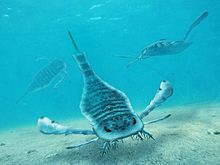Eurypterid
![]()
The title of this article is ambiguous. For a description of the fish species, see Sea scorpion.
As sea scorpions, giant scorpions, or eurypterids (Eurypterida, from Old Greek εὐρύς m., (εὐρεῖα f., εὐρύ n.) - 'broad' and πτερόν - 'wing', 'fin': "broad-finned") is the name given to an extinct group of jawed chelicerids (Chelicerata) which, together with the swordtails (Xiphosura), are included in the taxon Merostomata. This group is contrasted with the other chelicerates, the arachnids (Arachnida), as a separate class.
Like the swordtails, the eurypterids were primarily marine dwellers and were only found there from the Ordovician to the Permian. Afterwards, they also established themselves in brackish and fresh water, possibly some species could also survive on land for a short time. In 2005, the fossil movement track of a Hibbertopterus was discovered that had clearly originated on land, thus providing evidence that sea scorpions could leave the water, at least for a short time. With a body length of over two metres, some species of this group, such as Eurypterus spec., are the largest arthropods known.
The eurypterids had a narrow carapace with an only slightly articulated head shield (prosoma) and an abdomen (opisthosoma) with twelve segments. The legs and other limbs attached exclusively to the prosoma, as in modern spiders and their relatives, and the rearmost pair of legs was remodeled into large webbed legs. The foremost leg limbs as well as the chelicerae were equipped with pincer-like structures and teeth, which enabled them to hold on to prey. Accordingly, the eurypterids can be regarded as dangerous prey grabbers of the vertebrates and large invertebrates of that time.
Very detailed preserved specimens of the genus Eurypterus were already found in 1898 from dolomite rocks of the Silurian on the island of Ösel (Estonia). The finest details could be observed on these animals, such as the male and female genital appendages on the second segment of the abdomen. In 1995, eurypterids were also found in the Soom Shale of South Africa, in which details of the musculature and internal organs could still be seen.

Eurypterus in an artistic living reconstruction
Questions and Answers
Q: What are eurypterids related to?
A: Eurypterids are related to arachnids.
Q: What is the largest known arthropod?
A: The eurypterids are the largest known arthropods.
Q: How long were the largest eurypterids?
A: The largest eurypterids, such as Jaekelopterus, reached 2½ metres in length.
Q: When did eurypterids thrive?
A: Eurypterids thrived in the warm, shallow seas and lakes of the Ordovician to the Permian periods, around 460 to 248 million years ago.
Q: When did eurypterids go extinct?
A: Eurypterids went extinct during the Permian-Triassic extinction event 251 million years ago.
Q: What is the typical eurypterid body structure?
A: The typical eurypterid had a large, flat, semicircular carapace, followed by a jointed section, and finally a tapering, flexible tail, most ending with a long spine at the end.
Q: What is the telson in eurypterids?
A: The tail in eurypterids, known as the telson, is spiked in most eurypterids.
Search within the encyclopedia